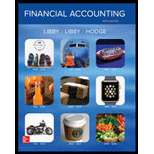
1.
Compute the turnover, liquidity, and solvency ratios for the current year of Company T.
1.
Answer to Problem 13.4AP
Turnover, liquidity, and solvency ratios for the current year of Company T are as follows:
| Ratios or percentages | Result |
| Turnover Ratios | |
| Total asset turnover | 0.55 |
| Fixed asset turnover | 1.10 |
| Receivable turnover ratio | 1.59 |
| Inventory turnover ratio | 1.65 |
| 2.59 | |
| Quick ratio | 2.01 |
| Cash ratio | 1.15 |
| Solvency Ratios | |
| Debt-to-equity ratio | 0.67 |
| Cash coverage ratio | 3.84 |
| Times interest earned ratio | 5.50 |
Table (1)
Explanation of Solution
Turnover ratios: Following are the types of turnover ratios:
- Total Asset turnover: Total asset turnover is a ratio that measures the productive capacity of the total assets to generate the sales revenue for the company. Thus, it shows the relationship between the net sales and the average total assets.
- Fixed Asset turnover: Fixed asset turnover is a ratio that measures the productive capacity of the fixed assets to generate the sales revenue for the company. Thus, it shows the relationship between the net sales and the average total fixed assets.
- Receivables turnover ratio: Receivables turnover ratio is mainly used to evaluate the collection process efficiency. It helps the company to know the number of times the accounts receivable is collected in a particular time period. This ratio is determined by dividing credit sales and sales return.
- Inventory Turnover Ratio: This ratio is a financial metric used by a company to quantify the number of times inventory is used or sold during the accounting period.
Liquidity Ratios: Liquidity explains the extent of cash’s nearness to assets and liabilities. It explains how easily assets can be converted into cash. Following are the types of ratios that help to find liquidity position of a company.
- Current ratio: Current ratio is one of the liquidity ratios, which measures the capacity of the company to meet its short-term obligations using its current assets.
- Quick ratio: It is a ratio used to determine a company’s ability to pay back its current liabilities by liquid assets. Liquid assets such as cash and cash equivalents, marketable securities and net account receivables.
- Cash ratio: This ratio is used to measure the adequacy of the cash in the business. It is determined by dividing cash equivalents and current liabilities.
Solvency ratio: Solvency ratio measures the capacity of a company to sustain over a long period of time. Solvency ratios are debt to assets ratio, time interest earned ratio, and debt to equity ratio, and more.
- Debt-equity ratio: The debt-to-equity ratio indicates that the company’s debt as a proportion of its
stockholders’ equity . - Cash coverage ratio: This ratio indicates the relationship between the
cash flows from operating activities and the interest payments. - Times interest earned ratio: Times interest earned ratio quantifies the number of times the earnings before interest and taxes can pay the interest expense. First, determine the sum of income before income tax and interest expense. Then, divide the sum by interest expense.
Determine the ratios of Company T as given below:
| Ratios or percentages | Formula | Calculation | Result |
| Turnover Ratios | |||
| Total asset turnover | 0.55 | ||
| Fixed asset turnover | 1.10 | ||
| Receivable turnover ratio | 1.59 | ||
| Inventory turnover ratio | 1.65 | ||
| Liquidity Ratios | |||
| Current ratio | 2.59 | ||
| Quick ratio | 2.01 | ||
| Cash ratio | 1.15 | ||
| Solvency Ratios | |||
| Debt-to-equity ratio | 0.67 | ||
| Cash coverage ratio | 3.84 | ||
| Times interest earned ratio | 5.50 | ||
Table (2)
Working Note:
Determine the amount of average total assets:
Determine the amount of average net fixed assets.
Determine the amount of net credit sales.
Determine the amount of average net receivables.
Determine the amount of average inventory.
Determine the amount of current assets.
Determine the amount of current liabilities.
Determine the amount of quick assets.
Determine the amount of total liabilities.
Determine the amount of total stockholders’ equity.
2.
To write: A comment on the turnover ratios for the current year of Company T.
2.
Explanation of Solution
From Table (1), the results reveal that the average collection period and the average days to sell inventory is very long. Company T takes 229.56 days
Want to see more full solutions like this?
Chapter 13 Solutions
Financial Accounting
- Which accounting principle requires that expenses be matched with revenues in the period in which they are incurred to produce those revenues? A) Going Concern Principle B) Matching Principle C) Consistency Principle D) Conservatism Principle MCQarrow_forwardSolve this questions?arrow_forwardWhich account is not closed at the end of an accounting period? Consider typical accounts maintained in the general ledger. (A) Sales (B) Wages Expense (C) Capital (D) Rent Revenue MCQarrow_forward
 Managerial Accounting: The Cornerstone of Busines...AccountingISBN:9781337115773Author:Maryanne M. Mowen, Don R. Hansen, Dan L. HeitgerPublisher:Cengage Learning
Managerial Accounting: The Cornerstone of Busines...AccountingISBN:9781337115773Author:Maryanne M. Mowen, Don R. Hansen, Dan L. HeitgerPublisher:Cengage Learning Managerial AccountingAccountingISBN:9781337912020Author:Carl Warren, Ph.d. Cma William B. TaylerPublisher:South-Western College Pub
Managerial AccountingAccountingISBN:9781337912020Author:Carl Warren, Ph.d. Cma William B. TaylerPublisher:South-Western College Pub Intermediate Accounting: Reporting And AnalysisAccountingISBN:9781337788281Author:James M. Wahlen, Jefferson P. Jones, Donald PagachPublisher:Cengage Learning
Intermediate Accounting: Reporting And AnalysisAccountingISBN:9781337788281Author:James M. Wahlen, Jefferson P. Jones, Donald PagachPublisher:Cengage Learning College Accounting, Chapters 1-27AccountingISBN:9781337794756Author:HEINTZ, James A.Publisher:Cengage Learning,
College Accounting, Chapters 1-27AccountingISBN:9781337794756Author:HEINTZ, James A.Publisher:Cengage Learning,



